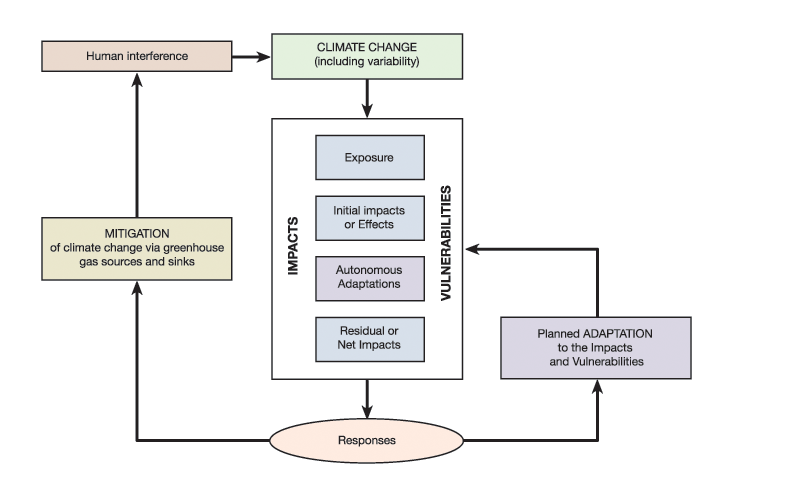Chapter 1 - Introduction

FIGURE 1: Adaptation and mitigation in the context of climate change (from Smit et al., 1999).
[larger image] | [text version]
The Earth's climate is changing. A growing body of scientific literature provides unequivocal evidence of global warming that is associated with changes in a wide array of other climate parameters, including precipitation patterns and extreme climate events (Intergovernmental Panel on Climate Change, 1995, 2001a, 2007a). These changes in climate are having observable impacts on both natural and human systems (Intergovernmental Panel on Climate Change, 2007b), with significant social, economic and environmental implications. This strong body of science has contributed to the development of a range of policy initiatives, at local to global scales, to address both the causes and the consequences of climate change.
While natural factors and human activity influence global climate, the burning of fossil fuels and changes in land-use patterns have been the dominant causes of climate changes observed since the mid-twentieth century (Intergovernmental Panel on Climate Change, 2007a). These human activities are expected to continue to dominate natural factors through the present century and beyond, leading to rates of global warming that far exceed those experienced in the past several thousand years (Intergovernmental Panel on Climate Change, 2007a). Reduction of greenhouse gas emissions, referred to as mitigation in the climate change literature, is critical to limiting the rate and magnitude of future climate change. However, due to the inertia of the Earth 's climate system, we are already committed to some further degree of climate change; temperatures and sea level will continue to rise regardless of global efforts to limit greenhouse gas emissions (Intergovernmental Panel on Climate Change, 2007a). As a result, adaptation is necessary to deal with the current and near-term impacts of climate change (Intergovernmental Panel on Climate Change, 2007b).
Adaptation typically provides local benefits that are realized relatively quickly after implementation, as opposed to mitigation, whose benefits are mostly global in scale and generally characterized by long lag times (Füssel and Klein, 2006), although co-benefits may be realized immediately. Mitigation and adaptation are essential and complementary policy responses to meeting the challenges presented by climate change (Figure 1). The amount and cost of adaptation required are a direct function of the rate and magnitude of climate change. Action on mitigation is necessary to "avoid the worst impacts of climate change" (Stern, 2006) and to enhance the feasibility of effective adaptation.
Throughout this report, the term 'climate change' refers to any change in climate over time, whether it is the product of natural factors, human activity or both. This usage is the same as that of the Intergovernmental Panel on Climate Change, but it differs from the usage in the United Nations Framework Convention on Climate Change, which restricts the term to climate changes that can be directly or indirectly related to human activity that alters the composition of the atmosphere, and is additional to natural climate variability.
Adaptation refers to any modification in a system or process made in response to changing climate. Adaptation involves making adjustments in our decisions, activities and thinking because of observed or expected changes in climate, with the goals of moderating harm or taking advantage of new opportunities (Intergovernmental Panel on Climate Change, 2001b). It is not a new concept: indeed, humans and ecosystems have always adapted to current and changing climates. In natural ecosystems, adaptation occurs spontaneously in response to climate impacts, whereas adaptation in human systems may also be undertaken in anticipation of changes in climate (Smithers and Smit, 1997). While the concept of adaptation is simple, the process of adaptation within human systems is complex. Adaptation actions are tremendously diverse and may involve, for example, behavioural changes; operational modifications; technological interventions; and revised planning and investment practices, regulations and legislation. They entail both monetary and non-monetary costs (cf. Smit et al., 2000; F üssel and Klein, 2006). The most appropriate adaptation actions for any given issue are determined by a wide range of social, economic and environmental factors (see Chapter 2). In many cases, adaptation will involve careful planning, guided by both scientific research on climate change and detailed understanding of the systems involved.
Page details
- Date modified: